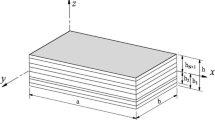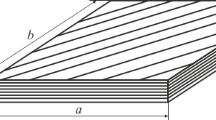Abstract
This paper presents a simplified 4-unknown shear and normal deformations theory for the bending analysis of cross-ply laminated plates. The present theory accounts for an adequate distribution of transverse shear strains through the plate thickness and tangential stress-free on the plate surfaces. The effect of normal strain is also included. The governing, equilibrium equations and boundary conditions are derived by employing the virtual work principle. Numerical results for stresses and displacements are compared well with those obtained using 3-D elasticity solution.















Similar content being viewed by others
References
Aydogdu M 2009 A new shear deformation theory for laminated composite plate. Compos. Struct. 89: 94–101
Batista M 2010 The derivation of the equations of moderately thick plates by the method of successive approximations. Acta Mech. 210: 159–168
Bogdanovich A E and Pastore C M 1996 Mechanics of textile and laminated composites with applications to structural analysis. London: Chapman & Hall
Ferreira A J M and Roque C M C 2011 Analysis of thick plates by radial basis functions. Acta Mech 217: 177–190
Ferreira A J M, Roque C M C and Jorge R M N 2005 Analysis of composite plates by trigonometric shear deformation theory and multiquadrics. Comput. Struct. 83: 2225–2237
Fiedler L, Lacarbonara W and Vestroni F 2010 A generalized higher-order theory for multi-layered, shear-deformable composite plates. Acta Mech. 209: 85–98
Jun L and Hongxing H 2009 Dynamic stiffness analysis of laminated composite beams using trigonometric shear deformation theory. Compos. Struct. 89: 433–442
Kant T, Gupta A B, Pendhari S S and Desai Y M 2008 Elasticity solution for cross-ply composite and sandwich laminates. Compos. Struct. 83: 13–24
Kapuria S and Kumari P 2010 Three-dimensional piezoelasticity solution for dynamics of cross-ply cylindrical shells integrated with piezoelectric fiber reinforced composite actuators and sensors. Compos. Struct. 92: 2431–2444
Khabbaz R S, Manshadi B D and Abedian A 2009 Nonlinear analysis of FGM plates under pressure loads using the higher-order shear deformation theories. Compos. Struct. 89: 333–344
Love A E H 1944 A treatise on the mathematical theory of elasticity. 4th ed. New York, USA: Dover Publ
Mantari J L, Oktem A S and Soares C G 2012a Bending response of functionally graded plates by using a new higher order shear deformation theory. Compos. Struct. 94: 714–723
Mantari J L, Oktem A S and Soares C G 2012b A new higher order shear deformation theory for sandwich and composite laminated plates. Compos. B 43: 1489–1499
Mindlin R D 1951 Influence of rotatory inertia and shear on flexural motions of isotropic, elastic plates. ASME. J. Appl. Mech. 18: 31–38
Neves A M A, Ferreira A J M, Carrera E, Cinefra M, Roque C M C, Jorge R M N and Soares C M M A quasi-3D hyperbolic shear deformation theory for the static and free vibration analysis of functionally graded plates. Compos. Struct. 94: 1814–1825
Neves A M A, Ferreira A J M, Carrera E, Roque C M C, Cinefra M, Jorge R M N and Soares C M M 2012b A quasi-3D sinusoidal shear deformation theory for the static and free vibration analysis of functionally graded plates. Compos. B 43: 711–725
Pagano N J 1970 Exact solutions for rectangular bidirectional composites and sandwich plates. J. Compos. Mater. 4: 20–24
Pagano N J and Hatfield S J 1972 Elastic behaviour of multilayered bidirectional composites. AIAA J. 10: 931–933
Reddy J N 1984 A simple higher-order theory for laminated composite plates. J. Appl. Mech. 51: 745–752
Reissner E 1944 On the theory of bending of elastic plates. J. Math Phys. 23: 184–191
Reissner E 1945 The effect of transverse shear deformation on the bending of elastic plates. ASME. J. Appl. Mech. 12: 69–77
Touratier M 1991 An efficient standard plate theory. Int. J. Eng. Sci. 29: 901–916
Xiang S, Wang K, Ai Y, Sha Y and Shi H 2009 Analysis of isotropic, sandwich and laminated plates by a meshless method and various shear deformation theories. Compos. Struct. 91: 31–37
Zenkour A M 2004a Analytical solution for bending of cross-ply laminated plates under thermo-mechanical loading. Compos. Struct. 65: 367–379
Zenkour A M 2004b Thermal effects on the bending response of fiber-reinforced viscoelastic composite plates using a sinusoidal shear deformation theory. Acta Mech. 171: 171–187
Zenkour A M 2005a A comprehensive analysis of functionally graded sandwich plates: Part 1 Deflection and stresses, Part 2 Buckling and free vibration. Int. J. Solids Struct. 42: 5224–5258
Zenkour A M 2005b On vibration of functionally graded plates according to a refined trigonometric plate theory. Int. J. Struct. Stab. Dynam. 5: 279–297
Zenkour A M 2006 Generalized shear deformation theory for bending analysis of functionally graded plates. Appl. Math. Model 30: 67–84
Zenkour A M 2007a Benchmark trigonometric and 3-D elasticity solutions for an exponentially graded thick rectangular plate. Arch. Appl. Mech. 77: 197–214
Zenkour A M 2007b Three-dimensional elasticity solution for uniformly loaded cross-ply laminates and sandwich plates. J. Sandw. Struct. Mater. 9: 213–238
Author information
Authors and Affiliations
Corresponding author
Appendices
Appendix A
The elements J ij = J ji of the matrix elements [J] appeared in Eq. (11) are given by
where d i , d ij , d ijl , d ijlm are the following differential operators:
Appendix B
The elements \(\bar {J}_{ij} =\bar {J}_{ij} \) of the matrix elements \(\left [ \bar {J} \right ]\) appeared in Eq. (17) are given by
Rights and permissions
About this article
Cite this article
ZENKOUR, A.M. A simplified four-unknown shear and normal deformations theory for bidirectional laminated plates. Sadhana 40, 215–234 (2015). https://doi.org/10.1007/s12046-014-0306-x
Received:
Revised:
Accepted:
Published:
Issue Date:
DOI: https://doi.org/10.1007/s12046-014-0306-x




